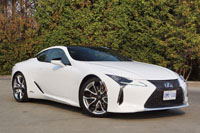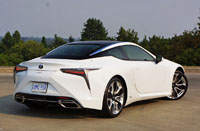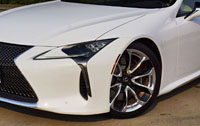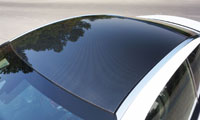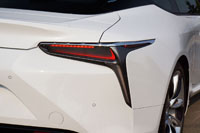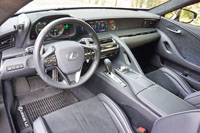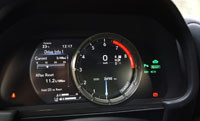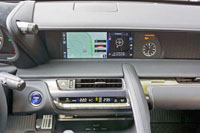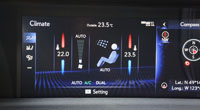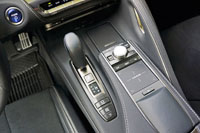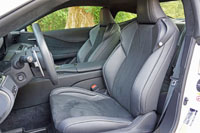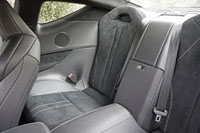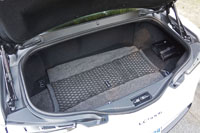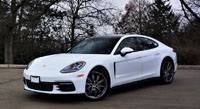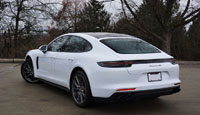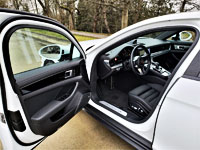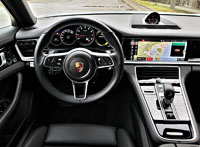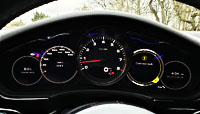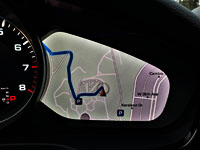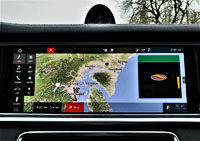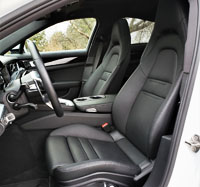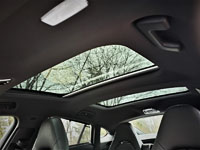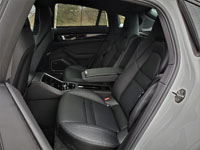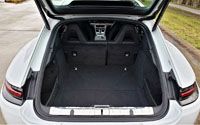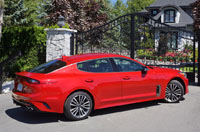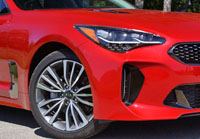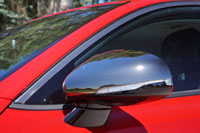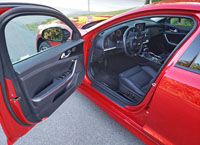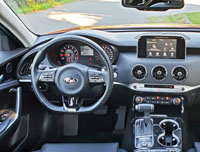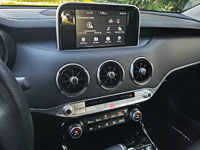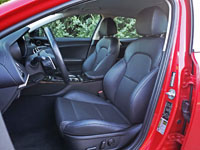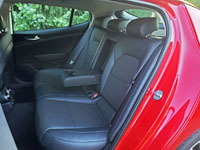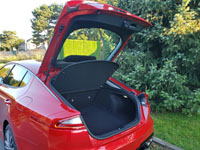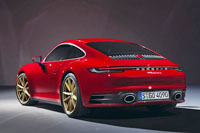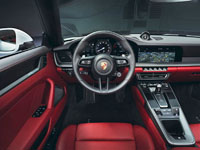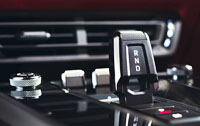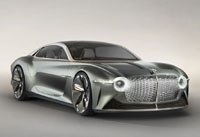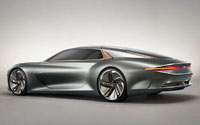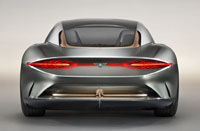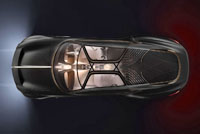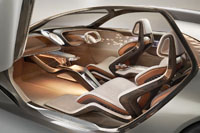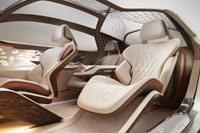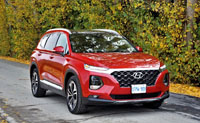
With Genesis now taking its place amongst more established premium brands, having initially pulled two of the South Korean namesake automaker’s most premium models (the Genesis sedan/G80 and Equus/G90) with it before adding one of its own (the new G70), Hyundai now appears to be working hard at differentiating its styling from the very luxury brand it created, while also keeping its look unique from in-house rival Kia, which shares underpinnings with most models across its lineup.
I believe they’ve done a good job thus far. Comparing the two brands’ mid-size sport utility offerings, the third-generation Hyundai Santa Fe and the current Kia Sorento looks as different as Toyota’s Highlander and Honda’s Pilot, yet they share plenty of components and therefore have saved costs in production and development.
That third-generation Santa Fe is mostly gone, however, replaced by the all-new 2019 Santa Fe shown on this page. I say mostly only because the long-wheelbase three-row Santa Fe XL still exists, currently selling alongside the new 2020 Hyundai Palisade, at least until stock dries up. The Palisade is a radical departure from the Santa Fe XL in styling and execution, and so is the completely redesigned Santa Fe.
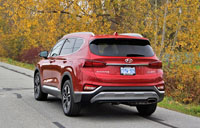
The new grille design is big, deep and totally distinctive, while the new Santa Fe’s innovative frontal lighting, comprised of narrow LED strips up top and tightly grouped clusters of secondary driving lights below, is now showing up on the brand’s latest designs, including the entry-level Kona and that top-tier Palisade just noted.
Sizes in mind, not everyone agrees on the Santa Fe’s segment categorization. Its first generation was more compact than mid-size, but over the years it grew to the point that its third-generation model was sized closer to the majority of mid-size five-passenger crossover SUVs, coming very close to matching the length, width and height of the Ford Edge, for instance.
The new one has grown yet again, measuring 4,770 millimetres (187.8 inches) from nose-to-tail and 1,890 mm (74.4 in) from side-to-side, which means that it’s 246 mm (9.7 in) longer than the Ford Escape compact SUV, yet only 9 mm (0.3 in) shorter than the Edge, while it is 52 mm (2.0 in) wider than the former Ford and just 38 mm (1.5 in) narrower than the latter. As for an in-house comparison, the new 2019 Santa Fe is a full 70 mm (2.7 in) longer and 10 mm (0.4 in) wider than the outgoing 2018 model, this upping interior volume. So therefore, while I have long deemed the Santa Fe a mid-size crossover SUV, now no one should categorize it differently.
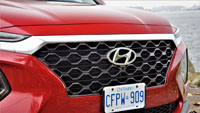
The Santa Fe has been with us for almost 20 years, and has always enjoyed extremely strong sales in Canada. In fact, it once again placed top of the mid-size SUV heap last year thanks to 24,040 deliveries, which put it well ahead of the second-place Edge just mentioned, the five-seat Ford only managing to coax 19,156 Canadian buyers over to its side last year. Santa Fe sales success isn’t a new phenomenon either, with the model holding first place in this category for as long as I’ve collected records (yes, I’ve actually kept running tabs on Canadian and US vehicle sales for more than 10 years).
I won’t go into too much detail about the new Santa Fe’s exterior design, only to say that it had a tough act to follow, and that I think they’ve done a good job with the new fourth-gen styling. As for the 2019 Santa Fe’s interior design, quality, fit, finish, and more, I’m quite certain you’ll be impressed. It’s one of the most luxurious crossover SUVs in its segment, with more pliable soft-touch surfaces than the majority of challengers, the entire mid-portion of its dash-top made up of stitched and padded composite that looks like real leather, this high level of finishing continuing downward with a similar surface treatment on the lower console sides, each door panel armrest, as well as the door inserts.
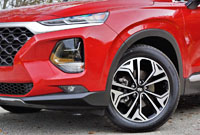
Moving upward, each front and rear door upper receives high-quality premium soft-touch composite surfacing too, with the Santa Fe’s only hard plastic including the most forward section of the dash top, the oval instrument binnacle surround, a small section on the door panels, all of the lower door panels, plus the lower instrument panel. Being that these surfaces are not often touched, most mainstream volume carmakers do the same, and considering how nicely Hyundai has detailed out the mesh metal-look décor inlays that wrap around the upper edge of the instrument panel into the doors front to rear, plus the attractive variation on that metal-look theme seen lower down on those door panels, which are actually speaker grills for the top-line Infinity sound system, I believe it’s okay they didn’t go over the top with soft, pliable composites.
Along with all the lovely metal trim just mentioned, Hyundai also includes plenty of satin-finish aluminum-look highlights throughout the Santa Fe’s cabin. Specifically, the gauge cluster gets circled in metal brightwork, while a similar treatment gets applied it to some of the steering wheel’s switchgear, and to the tablet-style infotainment touchscreen, plus the dash vents, the two-zone auto HVAC interface, the gear selector, the door pulls, the attractively finished power window switches and side mirror controller, etcetera.
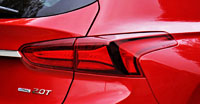
As impressive as all of the above is, the first thing that caught my eye when sliding behind the wheel of my top-line Santa Fe Ultimate was its luxuriously finished, thoroughly unique headliner. Looks like denim, but not blue jeans. Instead, the soft material is dyed light beige with browner flecks within. It looks really nice, plus Hyundai uses it to all of the Santa Fe’s roof pillars from front to rear, which is unheard of in this mainstream segment.
The distinctive roofliner is used for the large panoramic sunroof’s powered sunshade too, which can be opened by pressing a double-duty button that also tilts or slides back the glass to let air circulate from above. The overhead console includes buttons for LED reading lamps too, while it also contains a sunglasses holder that’s as nicely finished inside as the headliner is on the outside.
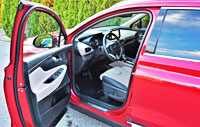
Notably, the new 2019 Santa Fe includes some updated trim line names, beginning with the base Essential model, which can be upgraded to Preferred, Preferred Turbo, Luxury, and finally as-tested Ultimate trim. The base Essential model, which starts at $28,999, includes a host of standard features such as heated front seats, a heatable steering wheel rim, 7.0-inch touchscreen infotainment with Apple CarPlay and Android Auto smartphone integration, a reverse camera with dynamic guidelines, two USB charging ports, Bluetooth, auto on/off projector headlamps with LED accents, fog lights, 17-inch alloy wheels, chrome and body-colour exterior detailing, a leather-wrapped steering rim wheel and shift knob, two-way powered driver’s lumbar support, 60/40 split folding rear seatbacks with recline, an electric parking brake with auto hold, Drive Mode Select with Comfort, Smart, and Sport modes, plus a lot more (make sure to check out all the pricing details right here on CarCostCanada, plus learn more about available rebates and make sure you find out about dealer invoice pricing before you buy, because it could save you thousands).
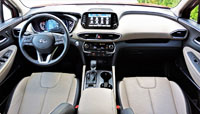
Hyundai’s suite of SmartSense advanced driver assistive systems pump the Santa Fe price up to $30,199, and include automatic high beam assist, dynamic cruise control with stop-and-go, forward collision alert and mitigation with pedestrian detection, lane keeping assist, plus Driver Attention Warning.
Adding all-wheel drive will increase the price by $2,000 in Essential trim, or AWD comes standard with the $35,099 Preferred model, at which point all of the SmartSense features get included too, plus blindspot detection, rear cross-traffic alert with collision avoidance, a rear occupant alert system that remembers if you opened a back door before driving and then reminds you that someone or something may still be in back when exiting, and finally safe exit assist that warns of traffic at your side when opening your door.

Additional Preferred trim features include 18-inch alloy wheels, turn signals added to reshaped side mirror housings, proximity-sensing keyless entry, pushbutton start/stop, an auto-dimming centre mirror, rear parking sonar, a universal garage door opener, two-zone auto climate control with a CleanAir Ionizer, Predictive Logic and auto defog, BlueLink smartphone telematics, satellite radio, an eight-way power driver’s seat, fore and aft sliding seats in the rear, etcetera. Notably the Santa Fe’s 2.4-litre base engine is still standard in Preferred trim, but you now have the $2,000 option of a 2.0-litre turbo-four.
Things get a lot nicer when upping the ante to the $41,899 Luxury model, which gets the turbocharged engine upgrade as well as standard AWD, plus darkened chrome exterior door handles, special door scuff plates, LED interior lighting, a 7.0-inch TFT LCD multi-information display within the gauge cluster, the previously noted power panoramic sunroof, a Surround View parking monitor, the deluxe cloth roofliner I went on and on about before, leather console moulding, memory, four-way powered lumbar support and an extendable lower cushion for the driver’s seat, an eight-way powered front passenger’s seat, perforated leather upholstery, cooled front seats, heated rear seats, second-row side window sunshades, a smart liftgate, etcetera.
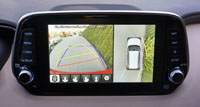
Finally, my tester’s $44,999 Ultimate trim featured pretty well everything from the Luxury model as well as 19-inch alloy wheels, satin-silver exterior trim and door handles, LED headlamps, LED fog lights, LED taillights, rain-sensing windshield wipers, a head-up display that projects key information onto the windscreen in front of the driver, a bigger 8.0-inch infotainment touchscreen featuring navigation and traffic flow info including incident data via HD radio, plus 12-speaker 630-watt Infinity audio with QuantumLogic Surround sound and Clari-Fi music restoration technology, a wireless charging pad, plus more.
The Santa Fe’s two engines are carried forward from last year, but both receive new variable valve timing for quicker response and fuel economy improvements. The base 2.4-litre four-cylinder engine still makes 185 horsepower and 178 lb-ft of torque, whereas the top-tier 2.0-litre turbo-four increases output to 235 horsepower and 260 lb-ft of torque. Those in the know will no doubt have noticed that this new upgraded powerplant is actually down by 5 horsepower, but as you might expect it’s not noticeable. In fact, the new Santa Fe feels quite a bit faster than the old model due to a more advanced eight-speed automatic transmission replacing the outdated six-speed cog-swapper, the new version also getting standard auto start/stop that turns off the engine when it would otherwise be idling, so as to reduce emissions and save on fuel.
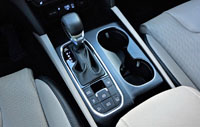
Fuel economy is thus improved, with the 2.4 FWD base model now given a rating of 10.8 L/100km city, 8.0 highway and 9.6 combined, compared to the outgoing model’s respective 11.1 city, 8.6 highway and 10.0 combined. The same 2.4-litre engine with AWD is now capable of a claimed 11.2 L/100km city, 8.7 highway and 10.1 combined compared to 12.0, 9.1 and 10.7 respectively with last year’s version, while this year’s 2.0-litre turbocharged engine is rated at 12.3 L/100km in the city, 9.8 on the highway and 11.2 combined instead of 12.5, 9.6 and 11.2 respectively for last year’s version. I found it surprising that all the gains, particularly the new eight-speed auto and auto start/stop system, didn’t make a difference in combined city/highway economy, but it’s probably still a positive when factoring in that most driving is done in the city.
Front-wheel drive is better for economy, but due to weather conditions most Canadians upgrade to all-wheel drive in this class. To that end, the Santa Fe’s HTRAC AWD system is quite sophisticated, as it sends most of engine torque to the front wheels in order to save fuel unless a slippery road surface needs additional traction in the rear, but this said you can apportion power to the front or back by choosing one of the available driving modes. Comfort mode, for instance, splits front/rear torque by a ratio of about 70/30 for all-weather stability, whereas Eco mode points more to the front wheels, Sport mode directs up to 50 percent to the rear wheels, and Smart mode varies all of the above as required.
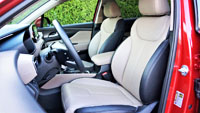
Like the third-generation Santa Fe, the new version integrates a fully independent suspension with MacPherson struts up front and a multi-link design in back, plus stabilizer bars at each end to improved road holding. Steering comes by a motor-driven powered rack and pinion system, feeling even more responsive than the old Sport’s system, while the suspension provided better at-the-limit handling as well as a nicer ride. I’m quite not sure how Hyundai provided such a compliant chassis while allowing for such impressive agility, but so it is. My tester even had the top-line 19-inch rims and lower-profile 235/55 all-season rubber, so it wasn’t as if its wheel/tire package was providing any extra cushioning, but I never once felt uncomfortable through my weeklong drive.
As I noted before, the updated turbocharged engine makes slightly less power than the previous one, but it never felt any less sporting when taking off from a standstill. The eight-speed automatic was nice and smooth, as expected from a modern multi-speed autobox, and shifted through the gears quickly enough too, while I should also note the Santa Fe’s Drive Mode Integrated Control System made the most of all of these components, especially in Sport mode that allows revs to increase between shifts, provides faster engagement, enhances throttle response, sharpens the steering feel, and as mentioned earlier, apportions up to 50 percent of the AWD system’s torque to the rear wheels, but honestly I left it in Smart mode most of the time because it creates a best-of-all-worlds scenario with the Eco mode’s fuel savings, Comfort mode’s smoother drivability, and Sport mode’s driver engagement, all depending on driving style.
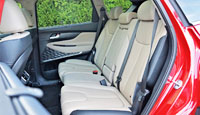
Family vehicles always compromise performance and comfort, mind you, which is the way it should be due to preferences of the majority of buyers in this class. The 10-way powered driver’s seat was wholly comfortable, its four-way power lumbar adjustment easily locating the small of my back. Cooling air can be blown through the perforations in the leather upholstery to keep derrieres cool in the summer’s heat, a comforting feature for sure, and there’s loads of room up front too. It’s spacious behind as well, made even more accommodating thanks to seat recliners that bend a long way backward, while the second row’s fore and aft sliding base allows for more cargo space when needed.
The interior of this five-seat Santa Fe measures 4,151 litres (146.6 cubic feet), whereas its total cargo volume is a generous 1,016 litres (35.9 cubic feet) aft of the second row and 2,019 litres (71.3 cubic feet) when those 60/40-split seatbacks are laid flat, a process that’s easier thanks to power release buttons attached to the cargo wall. This said, being that I’m a skier, I would have rather had 40/20/40-split rear seatbacks, or at least a centre pass-through, particularly in a vehicle with heated rear seats that can’t fully be used when 40-percent the rear seats are lowered to accommodate ski gear. Hyundai may want to reconsider this problem (as should many other carmakers) for the Santa Fe’s next mid-cycle upgrade.
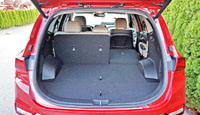
Still, the new 2019 Santa Fe is once again amongst the best five-passenger crossover SUVs on the market, so anyone considering a vehicle in this class should take one for a test drive.
Story credit: Trevor Hofmann
Photo credit: Trevor Hofmann

